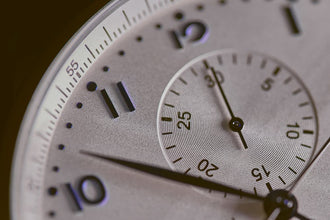

With every watch having its own beautiful design, taking great care of your watch is always at the forefront of your mind when you purchase a new timepiece.
However, sometimes, no matter what you try and do, you will find that scratches will unfortunately present themselves on the face of your watch.
Nevertheless, is there a way in which you can get rid of these scratches and have your watch look as good as new? Are there correct and wrong methods for completing this task? Carry on reading along with us to find out more!
Components of Your Watch Face
Before getting into the finer details of your watch face and the different components that compose the style of your watch - understanding the goals of a watch is crucial. Although these items for each brand have a goal of looking aesthetically pleasing - the main objective is to tell the time effectively.
With many opposing styles of watch hands, indices, colours, etc - every brand will have the possibility of creating their own unique guides for how each watch will look. Yet, many other components make up your watch.
To acknowledge the variations of materials and elements that watchmakers will use during the manufacturing process, let’s take a look at every part of your watch face that makes up the main aesthetic of your watch:
Hands
The hands, no matter what shape or size will always be the markers that will point to the time that you are on. However, the hand pointing to the hour will always be smaller than the hand pointing to the minute and seconds (if it has a hand for seconds).
Dial
The dial of your watch has the materials, colour and finish to the facet of your watch face. Therefore, this is an integral part of a watchmaker’s process for ensuring that the visual aspect of the watch is pleasant.
Indices
Whether you decide to go for Roman numerals, stick indices, regular numbers, etc - these markings will represent the time rather than telling you what time it is.
Bezel
Around your dial you will notice the bezel, typically containing markings or details about the dial as a whole. Watches such as dive watches will most likely accommodate your watch with a rotating bezel./p>
Sub-Dials
Depending on the watch you invest in - these sub-dial functions will differ. For example, miniature functions like tracking the lapsed seconds, minutes or even hours can be tracked. These tasks will all be completed in contrasting ways.
Crown
In essence, with the mainspring of your watch being extremely important for the watch’s function, the crown is the ruling energy supplier for the watch’s internal motion. Setting the time on your watch would be an impossible task without this feature - therefore it is crucial in keeping the watch functioning productively.
Polishing Scratches From a Watch Face: Our Guide
How to polish scratches from a watch face is a great question that we have been asked on multiple occasions by our customers. Well… before we dive deeper into the logistics and details of the procedure, let's take a look at the most favoured types of coverage for most watch faces.
Whether you’re looking at investing in an acrylic crystal or mineral glass - both will act as a secure mechanism for your watch hands and dial.
Although the mineral glass is newer to the scene and is more protective of your watch display - disregarding the acrylic crystal protector is ludicrous.
Both are extremely favoured as protectors for effective polishing. Nevertheless, when you search for solutions to polish your scratches off, it will be extremely difficult to trust which ones work and which ones don’t.
Ignoring the ones we don’t suggest here is a must - as it could potentially harm your watch and its visual appearance forever. Knowing that watches aren’t always affordable could be detrimental to either saving your watch from being worth less or making it completely worthless.
Before we get into the exact techniques you can utilise, here are the polishing agents you can use for our method:
- Toothpaste
- Displex
- Brasso
- Polywatch
Now that you know the exact substances you can apply, any of these can be used during our method of polishing. Reading our guide below will help you gain knowledge on the methods to use and the exact step-by-step process on how to effectively polish your watch using productive techniques:
Step 1:
Where you can see the bezel on your own personal watch, you will need to add some tape to wherever that is located. If your bezel gets damaged by the polishing agent, that will be just another fix that you will have to make - which is not what you want and or need when trying to fix a harmed watch already.
Therefore, covering the bezel with tape while using any of the substances named to polish your watch glass scratch is essential for other undamaged parts of your watch face.
Step 2:
Prior to acting on our solution, you will need to invest in a soft polishing rag or cloth (that could do an effective job on a window in your home) that can be delicately used on your watch face without causing more external impairment. Once you have that added to your appliances - you will need to add a small amount of your chosen substance onto the watch.
Step 3:
After a minimal amount of your chosen substance is added to your timepiece’s face, you will need to apply your rag or cloth and use a circular motion consistently for a few minutes (keep checking on it to see if the watch glass polishing has removed the scratch).
As long as the scratches aren’t too serious, this DIY glass polishing kit will work a treat and get rid of your scratches.
Instead of using a fibre glass scratch remover service or fibre glass scratch repair service - you will be able to spend a little amount of money to repair it yourself. However, if the scratches are too deep you may have to look into crystal replacement services nearby.
Check out this post to learn how to clean a silver watch.






